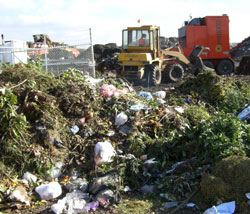Look what’s happening to our garden waste.
SGA visited the Epping Resource Recovery Facility in Victoria which was developed by Greenplanet and is now part of SITA. It’s turning our ‘green resource’ into quality mulch and compost – and it’s certified organic too. The finished product is shown here, still steaming hot!

‘Recycling is also about reusing!’ That was the word from Greenplanet’s sales manager Michael Rogers, seen here on the left with Greenplanet’s production manager Anthony Green. When the mulch made from your garden waste is this good, that’s enough reason to buy it back.
This SITA facility is recycling green waste from Whittlesea, and Whitehorse transfer stations and residents, and the Nillumbik kerbside collection and there are other similar facilities in most other states.

The amount of plastic bags and other non-compostable rubbish found in the kerbside green waste is very disappointing. The photograph here shows how important it is to keep rubbish out of green waste.
Greenplanet designed and built their own mulching machines. They developed a system of mulching to remove the rubbish, this means that 90% is recycled compared to only 30% in the past. The rest is rubbish that goes to landfill, as shown here.
Despite most of the rubbish being removed, kerbside waste will still have small, occasional particles of contaminants like plastic in the final compost, so this is blended with soil to create an organic soil blend.
Clean green waste that comes from waste transfer stations (the Tip in old-speak) doesn’t have the contaminants. It is this composted mulch product that is sold in bags or in bulk.
The Process
The green waste is mulched, then piled up in rows, called windrows.
The windrows are monitored stringently. They are turned regularly to keep the material aerated and to ensure that every bit of it is heated to more than 55 degrees for a sustained period of time. (This is required by the Australian Standards for composted mulches.) The high temperature kills weed seeds and pathogens – it’s pasteurization.
After a minimum of 21 days the pasteurized mulch is reground and passed through a screen to remove any large material (as seen here). The mulch is now ready to face the world – again!
Gardens love the addition of natural organic materials to improve soil quality and reduce evaporation. It also reduces the amount of insecticides and fungicides that you will need to use.
No chemical additives are used in the production of this mulch, so it complies with the highest standards and has the Compost Australia Leaf Mark.
Related Articles:
Low Impact Pest Management 101 Video
Sustainable Gardening 101 Video Series PART 3: Low Impact Pest Management Gardens are the natural habitat for all types of insects – the good, the…
Soil Farming 101 Video
Sustainable Gardening 101 Video Series PART 2: Soil Farming What’s the secret to success in the garden? It is all about the soil! We need to…



